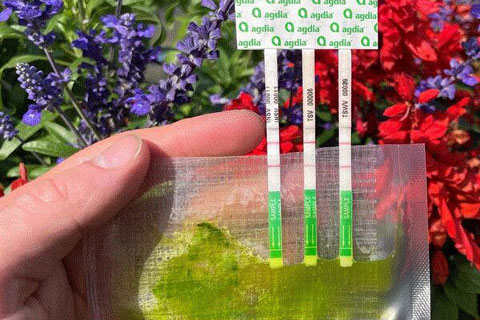2/1/2024
Get Familiar With In-house Disease Testing
Nick Flax

Some diseases have characteristic symptoms and can be identified based on these, especially when you’ve had previous experience with the disease in question. However, early symptoms for many diseases are often much less distinct and can be mistaken for abiotic disorders like mineral nutrient deficiencies or other factors. If you have a pathologist on staff or an in-house diagnostic lab, that’s great, but most of you don’t have either. So what can you use to quickly check for suspected bacterial and viral pathogens? Test kits!
Pictured: Test kits like Agdia’s ImmunoStrips for plant virus detection allow growers to test for multiple pathogens in the field, greenhouse or onsite labs.
What’s a pathogen test kit?
Test kits are typically made up of a few components, including a pouch containing a buffer solution and test strips that are kept separately until the test is performed. In general, test kits for bacterial and viral pathogens work in a similar way. You take some symptomatic plant tissue, mash it up in the buffer solution pouch and submerge the tip of the test strip in the solution. As the strip wicks the mashed-up plant “juice” plus buffer solution through itself, an indicator in the strip reacts with the solution. If the pathogen that the kit is designed to test for is present, the strip will indicate a positive result.
Why keep pathogen test kits on-hand?
Since the naked eye cannot see bacteria or viral particles, test kits are really the only way to home in on exactly which pathogen you’re dealing with. The alternative is to send plant samples off to a lab equipped with similar, higher-resolution diagnostic tools, but this can be time-consuming and costly, depending on the lab. In the meantime, while you wait to hear testing results, the pathogen could be spreading further through your crops and cause more damage because you weren’t able to react sooner. If you had a test kit on-hand, however, this would give you a much better idea of how to appropriately manage your disease risk when you first saw symptoms and potentially head it off sooner.
Important things to know about test kits
While test strip kits can be powerful tools for early disease detection, there are a few important things to know before using them:
■ Results from test strips are not the be-all, end-all of whether a disease is present. They’re strong indicators of the presence of specific pathogens, but follow-up testing in a lab setting should always be done to confirm which is present.
■ Some test strip kits test positive for multiple different pathogens. For example, Tobacco Mosaic Virus (TMV) test kits react with over a dozen tobamoviruses and additional testing is often needed to confirm exactly which one is causing disease.
■ Though test strip kits are usually quite accurate, they’re not infallible. False positives can occur, hence why follow-up testing in a lab is strongly encouraged. The best way to reduce the risk of false positives is to follow the kit instructions exactly as they’re written and ensure they’re properly stored until used.
■ Only test symptomatic plants. Blindly testing healthy crops is a waste of money and false positives could cause you to overreact and throw away plants unnecessarily.
■ Test strip kits have an expiration date. Shelf life of these kits is often more than long enough to carry you through a given year, but plan on doing a refresh on any unused test kits from one year to the next.
■ Because test strip kits are perishable, make sure you have an appropriate place to store them before use. Typical refrigerator temperatures—36 to 46F (2 to 8C)—are suitable.
When in doubt, reach out to a technical expert. If you’re ever uncertain of how to execute test kit instructions or interpret the results, reach out to your supplier or preferred diagnostician.
Which kind of test strip kit(s) should you have?
There are many different test kits for different viruses and bacterial pathogens, so it’s easy to get overwhelmed when deciding which ones to keep handy. You should maintain a supply of test kits for viruses or bacterial pathogens dealt with in the past—especially when they’ve had the same disease issue over multiple consecutive years. Here are some other considerations if you’re unsure as to which will be most worth your while:
If you’ve dealt with tospoviruses or other insect-transmitted viruses, it would be wise to have test kits for these viruses at the ready. Plants in the landscape around your greenhouse can serve as viral reservoirs from one year to the next and incoming pests can pick up the virus before entering your crops. Until you can fully eradicate viral reservoirs, keep a few test kits handy to help catch early symptoms. In this case, early virus detection can also serve as an indicator to ramp-up control measures for the virus’ insect vector and help reduce year-over-year losses.
Even if you don’t tangle with viruses often, it’s still wise to have a few test kits around just in case. Rather than getting individual test kits for common viruses, you can buy combination kits, which test for multiple groups of common viruses simultaneously. GT
Watch this video tutorial to learn how to perform an in-house pathogen test using ImmunoStrips from Agdia.
Nick Flax is a Technical Services Specialist with Ball Seed Company.